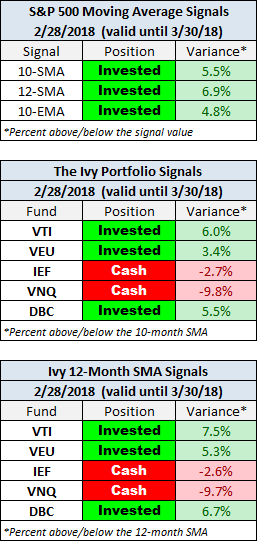
The S&P 500 closed February with a monthly loss of 3.89% after a gain of 5.62% in January. All three S&P 500 MAs are signaling “invested” and three of five Ivy Portfolio ETFs — Vanguard Total Stock Market ETF (VTI), Vanguard FTSE All-World ex-US ETF (VEU), and PowerShares DB Commodity Index (DBC) — are signaling “invested”.

The Ivy Portfolio
The above table shows the current 10-month simple moving average (SMA) signal for each of the five ETFs featured in The Ivy Portfolio. We’ve also included a table of 12-month SMAs for the same ETFs for this popular alternative strategy.
For a fascinating analysis of the Ivy Portfolio strategy, see this article by Adam Butler, Mike Philbrick, and Rodrigo Gordillo:
Backtesting Moving Averages
Over the past few years, we’ve used Excel to track the performance of various moving-average timing strategies. But now we use the backtesting tools available on the ETFReplay.com website. Anyone who is interested in market timing with ETFs should have a look at this website. Here are the two tools we most frequently use:
(requires a paid subscription)
Background on Moving Averages
Buying and selling based on a moving average of monthly closes can be an effective strategy for managing the risk of severe loss from major bear markets. In essence, when the monthly close of the index is above the moving average value, you hold the index. When the index closes below, you move to cash. The disadvantage is that it never gets you out at the top or back in at the bottom. Also, it can produce the occasional whipsaw (short-term buy or sell signal), which we’ve seen most recently in 2016.
Nevertheless, a chart of the S&P 500 monthly closes since 1995 shows that a 10- or 12-month simple moving average (SMA) strategy would have ensured participation in most of the upside price movement while dramatically reducing losses.
















